Hyundai
Elantra Front Brake Pads Replacement Guide
How to replace the front brake pads on a
2011, 2012 and 2013 Hyundai Elantra with picture illustrated instructions.
By Paul B. Michaels Author & Photographer Auto Mechanic Since 1989 |
||
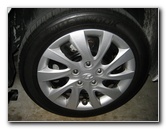 2011 Elantra Front Wheel |
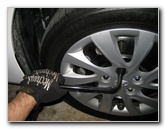 Loosen 5 Lug Nuts |
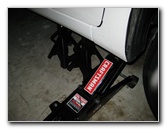 Raise Vehicle - Floor Jack |
| This
automotive maintenance "how-to" guide was specifically written to
assist owners of the 5th generation 2011, 2012 & 2013, 2014,
2015 & 2016 Hyundai Elantra
(also known as the Avante or i35) in replacing the front brake pads. Owners of other Hyundai or Kia vehicles such as the Accent, Sonata, Azera, Veloster, Tucson, Santa Fe, Veracruz, Genesis, Forte, Optima, Rio, Soul, Sorento, Sportage, and Sedona may also find these DIY instructions to be helpful. The tools needed to complete this front brake job include a floor jack, jack stands, a tire iron or lug nut wrench, a 14mm socket with a 3/8" drive ratchet, and an "F" clamp. A few compatible aftermarket sets of front brake pads include the following with their part numbers: Wagner QC1595, Raybestos PGD1543C, TRW TPC1595, Centric 105.15430, Akebono ProAct ACT1543A, KFE KFE1543-104, Bendix D1543 CQ and Bosch BC1543. |
||
|
|
||
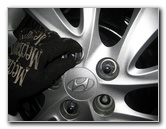 Remove Lug Nuts |
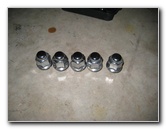 5 Lug Nuts Removed |
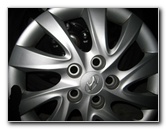 Pull Off Wheel Cover |
| The first few steps
are to engage the parking brake, chock the rear wheels and slightly loosen
the five lug nuts on each front wheel with a tire iron or lug nut wrench. Then raise the front of the vehicle with the floor jack and securely support it with at least two jack stands. Spin off the five lug nuts and set them aside in a safe place before pulling of the wheel cover (hub cap) and the wheel itself. |
||
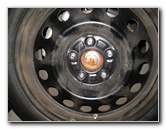 Pull Off Front Wheel |
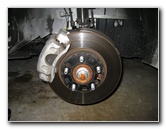 Front Brake & Rotor |
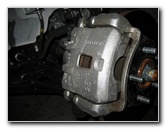 Brake Caliper & Bracket |
| Behind the front
wheel, you'll see the front brake rotor, brake caliper and caliper bracket. Look on the back side of the front brake caliper and locate the two 14mm caliper bolts. |
||
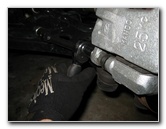 Loosen 14mm Caliper Bolt |
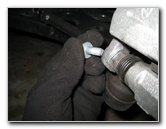 Remove Lower Caliper Bolt |
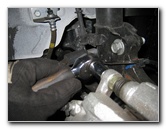 Remove Upper Caliper Bolt |
| Use the 14 mm
socket with a 3/8" drive ratchet to loosen the two caliper bolts by turning
them clockwise (to the right) as seen from the outside of the vehicle.
If you have trouble loosening the bolts, use a 14mm wrench and hit it with a rubber mallet to get the bolts turning. Be sure that you are turning them in the clockwise direction (or counter clockwise if you are underneath the car looking at the rear of the caliper). |
||
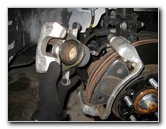 Pull Off Brake Caliper |
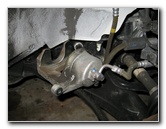 Rest Caliper On Suspension |
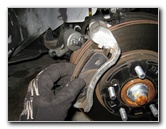 Remove Old Brake Pads |
| Once both the upper
and lower caliper bolts have been removed, you can carefully lift the brake
caliper out of the bracket and away from the rotor. Gently rest the brake caliper on the front suspension arm without placing stress on the rubber brake lines. Pull the old brake pads out of the caliper bracket and make a mental note of how the wear or "squeal" bar is orientated. On this 2011 Elantra GLS, the wear bar was situated at the bottom of the inner front brake pad. |
||
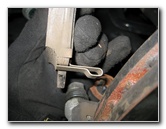 Wear Bar - Inner Bottom |
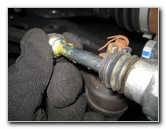 Pull Out Caliper Pin |
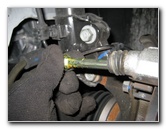 Check & Lubricate Pins |
| To ensure proper
braking performance and even pad wear, pull out the caliper slider pins from
their rubber boots and inspect their lubrication. If they aren't well
lubricated, apply a generous amount of high pressure moly lubricant or a
silicone based brake caliper grease. Then reinsert the caliper slider pins back into the caliper bracket until their rubber boots snap in place over the metal lip on the pins. |
||
|
|
||
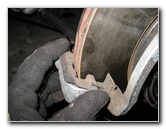 Replace Anti-Rattle Clip |
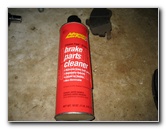 Brake Parts Cleaner Spray |
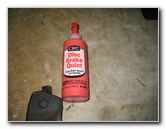 Disc Brake Quiet Gel |
|
If your new front brake pads kit came with new metal anti-rattle clips, pull out the old ones from the top and bottom of the caliper bracket and install the new ones in their place. Thoroughly clean off the brake rotor, caliper bracket, caliper and lug nut studs with brake parts cleaner spray. Do not use compressed air to clean off the brake parts since breathing in brake dust can be harmful to your health. To help prevent or reduce braking noise, an optional step is to apply some CRC Disc Brake Quiet gel or a similar product to the rear of the brake pads where they come in contact with the caliper. (Do not apply anything to the friction surface of the new pads.)
The service manual torque specification for tightening the larger bracket bolts is 51 to 63 lb-ft (or 69 to 85 N*m). |
||
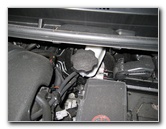 Brake Fluid Reservoir |
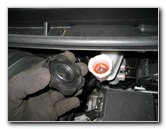 Twist Off Reservoir Cap |
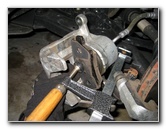 Compress Caliper Piston |
| In order for the
brake caliper to fit over the thicker new brake pads, the caliper piston
will need to be compressed backwards a bit with a "C" or "F" clamp. First move to the engine bay and remove the brake fluid reservoir cap by turning it counter clockwise. Removing the reservoir cap will allow the brake fluid to easily travel back through the brake lines when the caliper piston is compressed. Attach the "F" clamp to the brake caliper using the back of an old brake pad to evenly distribute the pressure. Very slowly compress the piston while repeatedly checking the brake fluid level in the reservoir to prevent it from overflowing. Compress the brake caliper piston until it is just about flush with the rubber dust boot. |
||
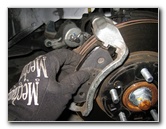 Install New Front Pads |
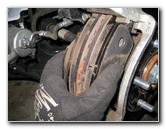 Press Pads Flush On Rotor |
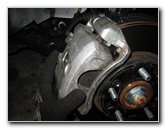 Replace Brake Caliper |
| Slide the new front
brake pads into the caliper bracket and push them together until they are
flush against the brake rotor. Carefully place the brake caliper over the new brake pads and down into the bracket. If the caliper won't fit over the brake pads, you may need to compress the caliper piston back a bit more. |
||
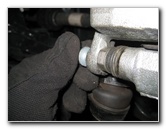 Insert 14mm Caliper Bolts |
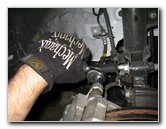 Tighten Upper Caliper Bolts |
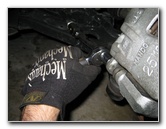 Tighten Lower Caliper Bolt |
| Line up the bolt
holes in the brake caliper with the holes in the caliper slider pins
installed in the bracket. Insert the two caliper bolts and thread them in a few turns by hand to prevent them from becoming cross threaded. Tighten the caliper bolts by turning them clockwise (left) as seen from the outside of the vehicle with the 14mm socket and ratcheting wrench to just past hand tight or about 20-25 ft lbs of torque. Note - The service manual's torque specification for the front caliper bolts is 15.9 to 23.1 lb-ft (or 21.6 to 31.4 N*m). Double check that the two caliper bolts are securely tightened before moving on to the next steps. |
||
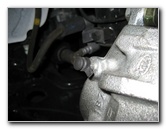 Brake Fluid Bleeder Valve |
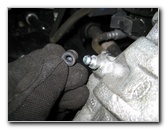 Bleeder Valve Rubber Cap |
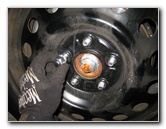 Replace Front Wheel |
| If your brake pedal
previously felt mushy or spongy, the brake fluid may be contaminated with
water or the brake lines may contain air bubbles.
It would be best to bleed the brake lines at this time in order to flush out the old fluid and replace it with fresh DOT 3 brake fluid. For more on this topic, check out my Brake Line Fluid Bleeding With An Assistant DIY Guide or alternatively the Brake Line Fluid Bleeding With A Power Bleeder Guide. |
||
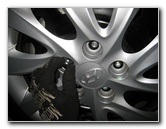 Replace Wheel Hub Cap |
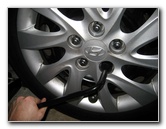 Spin On Lug Nuts |
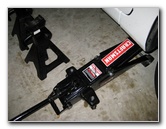 Lower Vehicle |
| Replace the front
wheel, snap on the plastic wheel cover, spin on the five lug nuts, and
tighten them a bit with the tire iron. Lower the vehicle down from the jack stands using the floor jack. |
||
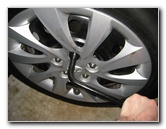 Tighten 5 Lug Nuts |
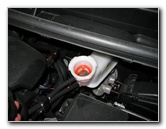 Check Brake Fluid Level |
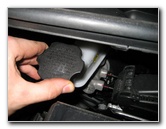 Replace Reservoir Cap |
| Progressively
tighten the five lug nuts in a "star" or "criss cross" pattern to just past
hand tight. It would be best to use a torque wrench or an air gun with a
torque stick to tighten the lug nuts to the owner's manual specification of
65 to 79 lb-ft (or 88 to 107 N*m). Note - The owner's manual torque specification for tightening the the lug nuts is 65.1 to 79.6 lb-ft (or 88.3 to 107.9 N*m). Please double check the owner's manual to verify the correct lug nut torque specification for your specific vehicle and wheel type. The larger 16" and 17 inch wheels have a lug nut torque specification of 80 to 94 lb-ft (or 108 to 128 N*m). Sit in the driver's seat of the vehicle and press the brake pedal a few times to restore the brake line pressure. Then check the brake fluid level in the reservoir and verify that it is at the proper level. If it is low, pour in some fresh DOT 3 brake fluid. Once the brake fluid level is correct, replace the brake fluid reservoir cap by twisting it on clockwise. To break in your new front brake pads, just drive normally for the first several hundred miles while trying to avoid any hard or "panic" stops which may glaze over the new brake pads and cause them to be noisy and not perform as well. It's also a good idea to regularly examine your driveway for drops of brake fluid which may indicate a leak, check the brake fluid level in the reservoir, and also check that the lug nuts are still properly tightened. For more, please check out my other
Hyundai Elantra Repair & Maintenance DIY Guides. |
||
| If you found this guide to be helpful,
please consider making a small donation by clicking on the PayPal.com
"Donate" button located to the right of this paragraph. Thank you!
(Note: I am not a registered charity. Donations are not tax deductible.) |

